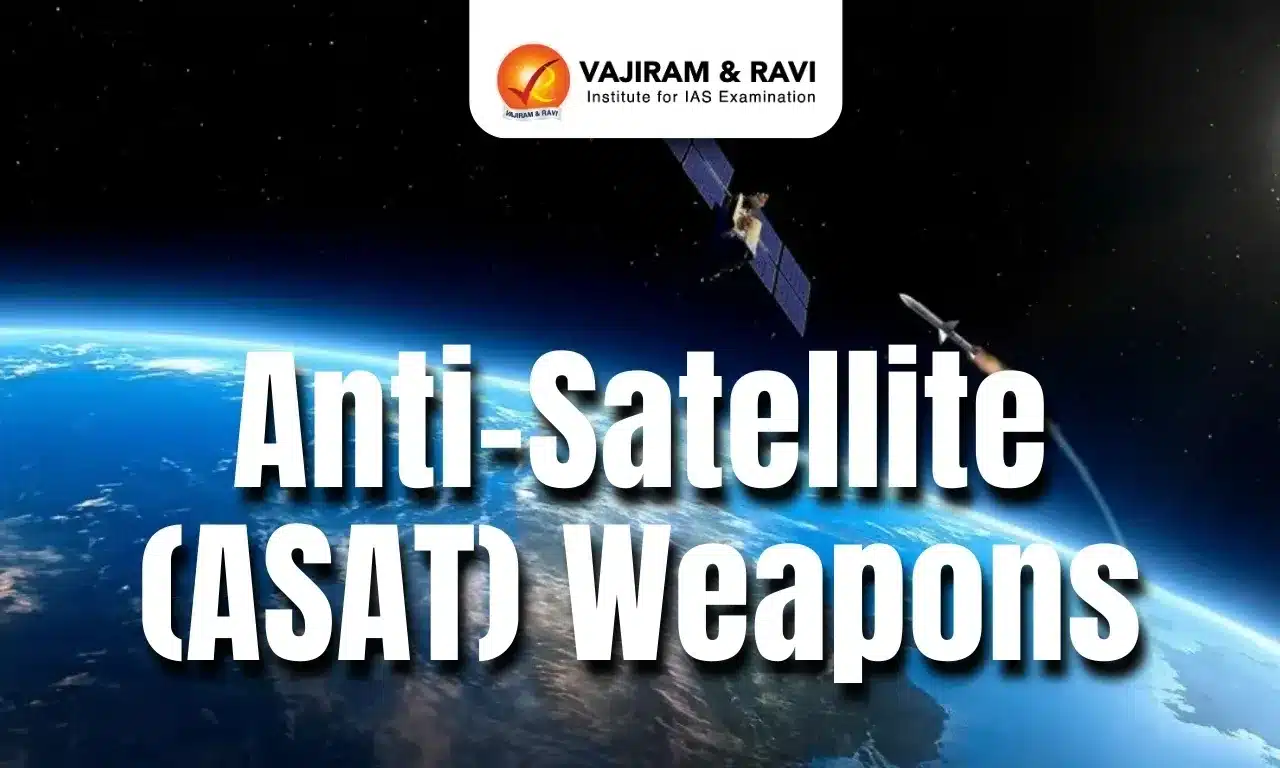Anti-Satellite (ASAT) Weapons Latest News
India is recognised as a key player in creating global norms for responsible space behaviour, said Marjolijn van Deelen, EU Special Envoy for Space. She highlighted India-EU collaboration at the Global Technology Summit.
About Anti-Satellite (ASAT) Weapons
- ASAT weapons are specialised technologies designed to disable, destroy, or interfere with satellites in orbit for strategic or defensive purposes.
- ASATs are a key component of space warfare capabilities and are used to neutralise enemy satellites for surveillance, communication, navigation, or early warning systems.
- ASAT weapons are broadly classified into two categories:
- Kinetic Energy ASATs: These involve direct physical impact, usually through missiles that collide with satellites to destroy them. The impact generates orbital debris, which can pose a long-term hazard to other space assets.
- Non-Kinetic ASATs: These use non-physical means such as cyber-attacks, jamming, spoofing, and directed energy weapons like lasers to disrupt or blind a satellite without physically destroying it.
- ASAT weapons can be launched from ground stations, aircraft, or even other satellites, making them versatile and difficult to detect in some cases.
- As of now, four countries — the United States, Russia, China, and India — have demonstrated operational ASAT capabilities through tests.
- India’s ASAT Test (Mission Shakti) was conducted in March 2019, where a live satellite in Low Earth Orbit (LEO) was destroyed by a three-stage interceptor missile at an altitude of around 300 km in a “hit-to-kill” mode.
- The global community, particularly the European Union (EU), has expressed concern about the space debris created by destructive ASAT tests and has called for a ban on such practices under the United Nations framework.
About Rendezvous and Proximity Operations (RPO)
- RPO refers to the intentional manoeuvring of one spacecraft close to another in space, either for docking, inspection, or other mission objectives.
- Rendezvous operations involve two space objects adjusting their orbital parameters, such as trajectory, plane, altitude, and phasing, to approach one another for docking or berthing.
- Proximity operations involve maintaining a spacecraft in the vicinity of another object on a pre-planned relative path without necessarily making contact.
- While RPOs are commonly used for scientific, repair, or refuelling missions, they can also be used for espionage, disruption, or disabling other satellites, especially if performed without prior notification or by unfriendly actors.
Source: TH
Last updated on June, 2025
→ UPSC Notification 2025 was released on 22nd January 2025.
→ UPSC Prelims Result 2025 is out now for the CSE held on 25 May 2025.
→ UPSC Prelims Question Paper 2025 and Unofficial Prelims Answer Key 2025 are available now.
→ UPSC Calendar 2026 is released on 15th May, 2025.
→ The UPSC Vacancy 2025 were released 1129, out of which 979 were for UPSC CSE and remaining 150 are for UPSC IFoS.
→ UPSC Mains 2025 will be conducted on 22nd August 2025.
→ UPSC Prelims 2026 will be conducted on 24th May, 2026 & UPSC Mains 2026 will be conducted on 21st August 2026.
→ The UPSC Selection Process is of 3 stages-Prelims, Mains and Interview.
→ UPSC Result 2024 is released with latest UPSC Marksheet 2024. Check Now!
→ UPSC Toppers List 2024 is released now. Shakti Dubey is UPSC AIR 1 2024 Topper.
→ Also check Best IAS Coaching in Delhi
Anti-Satellite (ASAT) Weapons FAQs
Q1. What are Anti-Satellite (ASAT) Weapons?+
Q2. When did India successfully test its first ASAT weapon?+
Q3. What was the target of India’s Mission Shakti ASAT test?+
Tags: anti satellite weapons Prelims Pointers upsc prelims current affairs
























